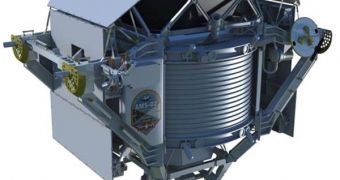In various new-age astronomy theories, dark matter and dark energy play central roles. In spite of the fact that even newer models have demonstrated that some yet-unexplained phenomena do not require the introduction of these elements in the equation, some scientists continue to push on for the creation of instruments capable of detecting them. One such device is the recently completed Alpha Magnetic Spectrometer (AMS), the crowning work of engineers at NASA and the US Department of Energy (DOE). It is currently scheduled to fly to the ISS aboard a shuttle mission in 2010.
Space-based spectrometers are not something new, but this instrument is particularly important because it represents the first one of its type to take a superconducting magnet to low-Earth orbit. The international physics community hopes that, through measurements collected with the AMS, they will be able to answer at least a small portion of yet-unanswered, Universe-related questions that deal with the origins and the future of the Cosmos, Space reports.
“Earth's atmosphere absorbs everything, so you cannot study primary cosmic rays until you go to space,” Samuel Ting, who is a physicist at the renowned Massachusetts Institute of Technology (MIT), explained back in 1994. Since then, efforts have been made to construct the AMS, and a launch schedule was set in place. However, as fortune had it, the flight was scheduled in the wake of the 2003 space shuttle Columbia disaster, in which seven astronauts died. The Congress subsequently canceled the flight, but the mission was eventually reinstated.
According to NASA's flight manifest, the new spectrometer will be taken to low-Earth orbit in either July or September, 2010, depending on the available room and last-minute additions or subtractions from the two respective shuttle missions. What has remained settled is that the AMS will launch, because of its outstanding importance. “The space station [AMS device] can detect particles of practically unlimited energy,” Ting added, which means that it can also hunt for proposed galaxies made of the elusive dark matter.
Its observations will probably build up on those obtained by the Italian satellite PAMELA, a high-energy particle observer launched in 2006. This observatory has already gathered some interesting leads on pinpointing the first clear pieces of evidence on dark matter, and the AMS will have the ability to either permanently confirm or deny these findings, and the dark matter/dark energy theory as a whole.

 14 DAY TRIAL //
14 DAY TRIAL //